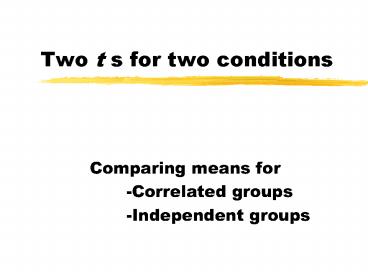Two t s for two conditions PowerPoint PPT Presentation
Title: Two t s for two conditions
1
Two t s for two conditions
- Comparing means for
- -Correlated groups
- -Independent groups
2
Which one to use?
- Use correlated groups t test for
- Repeated measures (before-after) designs
- Twin pair studies
- Matched pair studies
- Pair studies use what is often called paired
groups or paired samples design, as in SPSS - Use independent groups t test for designs which
have different people randomly assigned to the
two conditions
3
t for independent groups
t M1 - M2 sM1 - M2
SS1 SS2 1 1 (n1 n2 -2) n1
n2
sM1 - M2
4
Cohens d
- d (m1 - m2) / s
5
Assumptions underlying the t-test
- 1. Scores within the sample(s) must be based on
independent measurements. If the responses of
one participant influence the responses of
another, then the two scores are not independent. - 2. The underlying populations are normal.
- 3. The underlying populations have the same
variance, within chance variation. This is known
as the assumption of homogeneity. - The t-test is robust to violations of the
assumption of homogeneity if the sample sizes are
equal.
6
Testing the assumption of homogeneity of variance
- Hartleys F test
- Form a ratio of the variances, to see how many
times larger the greater variance is compared to
the lesser variance. - Thus, F larger variance/smaller variance
- Or F s1 / s2
- Compare the obtained value of F to the critical
value from table B-3, with k-1 degrees of freedom
between groups (numerator) and n-1 degrees of
freedom within groups (denominator).
7
t for correlated groups
- For correlated groups, first find D, the
differences between the members of the N paired
scores. - Then find SSD SD2 - (SD)2/N, where N is the
number of pairs of scores. - Finally, t
PowerShow.com is a leading presentation sharing website. It has millions of presentations already uploaded and available with 1,000s more being uploaded by its users every day. Whatever your area of interest, here you’ll be able to find and view presentations you’ll love and possibly download. And, best of all, it is completely free and easy to use.
You might even have a presentation you’d like to share with others. If so, just upload it to PowerShow.com. We’ll convert it to an HTML5 slideshow that includes all the media types you’ve already added: audio, video, music, pictures, animations and transition effects. Then you can share it with your target audience as well as PowerShow.com’s millions of monthly visitors. And, again, it’s all free.
About the Developers
PowerShow.com is brought to you by CrystalGraphics, the award-winning developer and market-leading publisher of rich-media enhancement products for presentations. Our product offerings include millions of PowerPoint templates, diagrams, animated 3D characters and more.

